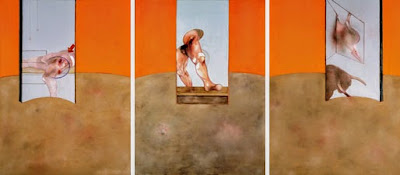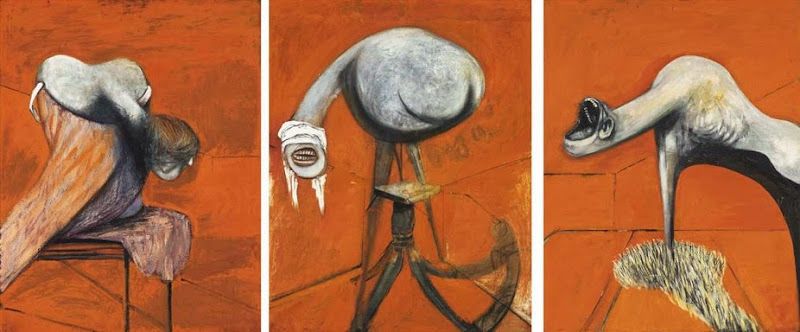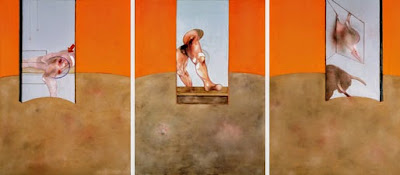Francis Bacon (Dublín 1909-Madrid 1992) es uno de los pintores británicos figurativos más respetados del siglo pasado. Produjo un arte original e inquietante al que llamó arte instintivo. Fiel reflejo de sus propios instintos, la pintura de Bacon es anti-narrativa y sugestiva por definición: Bacon no cuenta, sugiere.
Todo artista tiene puntos de referencia. Y en esto Bacon no es excepción. En 1929 es sorprendido por las figuras polimorfas del Picasso surrealista (exhibidas en la Galería Rosenberg de París). Su impacto es enorme. Fascinado por Picasso, cuya imaginería sugiere "forma orgánica que se relaciona con la figura humana pero es una distorsión completa de ella",[2] Bacon decide hacerse pintor. El embrujo de Picasso operará en él lentamente, para alcanzar expresión madura en sus Tres estudios para figuras al pie de una crucifixión de 1944 (Galería Tate, Londres).
En los años cincuenta, Bacon encuentra inspiración en una reproducción del Retrato del Papa Inocencio X por Diego Velázquez (Galería Doria, Roma). Mas el pintor inglés no hace de ella una mera copia, sino que parte de tal imagen para luego transformarla gradualmente. Su serie de aclamados Papas boquiabiertos presenta por sobretodo híbridos. En ellos Bacon combina al omnipresente Inocencio de Velázquez con una mujer desesperada del Acorazado Potemkin (su película favorita, junto con la obra cumbre del cine surrealista, Un perro andaluz, de Luis Buñuel y Salvador Dalí). De expresión ambigua, los Papas de Bacon resultan desconcertantes: gritan, se ríen a carcajadas, hacen muecas, aúllan, gimen, incluso se aburren... Y si semejante conducta papal puede parecer insólita, no menos lo es la intención del artista inglés: "Pintar como Velázquez, pero con la textura de una piel de hipopótamo."[3]
Aunque suene extraño, el factor común entre Bacon y Dalí es el paquidermo. Dalí se interesa por el cuerno del rinoceronte que—según él explica—lo conduce a un estado de "éxtasis."[4] Bacon, por su parte, no tiene empacho alguno en sugerir que la textura de la piel de un rinoceronte puede ayudarlo a evocar aquella de la piel humana.[5] Esto tiene su antecedente visual en las mismísimas pinturas instintivas: la actitud corporal del Hombre a gatas que Bacon pinta en 1952, tiene su prefiguración en aquella de un Rinoceronte, representado por él poco tiempo antes y durante el transcurso de ese mismo año. A la fascinación de Dalí por los rinocerontes se le agrega su capacidad para desconcertarnos a través de lo inusual y lo exagerado. Bacon está bien al tanto de esto. Cuando a principios de los setenta, el pintor inglés expresa su deseo de crear un "río de carne", él de hecho parafrasea a Dalí, cuya "carretilla de carne" data por lo menos de unos veinte años antes.[6]
 |
| Tríptico, realizado por Bacon en 1987 Faggionato Fine Art, Londres |
Las corridas son irresistibles para Bacon. Así lo testimonian sus óleos de 1969, conocidos como "Estudios". En ellos, el artista pone en práctica su muy riesgoso—y siempre presente—deseo de caminar por el borde un precipicio emocional. "Si uno ha visto alguna vez una corrida," dice Bacon, "no la olvida jamás."[7] La provocación, la masa bruta del toro, y la elegante figura del torero, todas ellas se dan encuentro en sus espectaculares Estudios de los sesenta tardíos. Es en ellos que la vida y la muerte se entremezclan, sin estar en absoluto exentas de lo grotesco.[8] Conciente del carácter erótico e inevitablemente fatal de la corrida, Bacon parece regocijarse al comentar que una buena corrida es el mejor aperitivo para toda actividad sexual.[9]
La muerte su amigo George Dyer, en 1971, despierta en Bacon gran interés por la poesía de Federico García Lorca, en cuyo Llanto por la muerte de Ignacio Sánchez Mejías, el pintor encontrará reflejado su propio dolor.[10] Al ser leído en su español original, Lorca conmueve al artista inglés.[11] "A las cinco de la tarde," cita Bacon, revelando su admiración por la demoledora congoja del poeta hispano.[12] "¡Qué no quiero verla!," escribe Lorca, refiriéndose a la muerte de su bizarro amigo íntimo. Y Bacon reelabora tal idea en términos visuales en las Tres figuras y retrato de 1975, dónde uno de los personajes evita ver el cuerpo del héroe caído, que se retuerce sobre la arena. Mas la actitud de Bacon con respecto a la muerte cambia con el tiempo. Así, Sangre en el piso (1986) nos recuerda "la sangre derramada" que abre la segunda parte del Llanto.[13] En Tríptico 1987, por otra parte, las imagenes no sólo evocan al Lorca del "toro solo corazón arriba" y a "la muerte [que] puso huevos en la herida" del héroe, sino que también nos confrontan, tal como lo hace el mismísimo poeta español, con el "cuerpo presente" de un hombre inolvidable, acaso irremplazable.[14] Paradójicamente, la elegía de Lorca da vida a la obra plástica de Bacon. Su influencia sobre la imaginería del artista británico resulta crucial. Ergo, es gracias a la poesía española que el arte baconiano finalmente expresa, no ciertas urgencias propias de las bestias, sino el sentir específicamente humano. Tal sentimiento es noble y por sobretodo transformador, y es debido al mismo que lo grotesco se torna sublime en el admirable arte pictórico de Francis Bacon.
Notas
[1] Artista plástico e historiador del arte, Mariano Akerman es autor de The Grotesque in Francis Bacon’s Paintings, 1999. Desarrolladas en tal investigación, las ideas del presente texto fueron expuestas y desarrolladas en la Universidad de Belgrano en un ciclo educativo cuyas ponencias tuvieron lugar inicialmente en la ciudad de Buenos Aires en 1999; las mismas serán retomadas en 2009.
[2] Bacon, entrevistado en 1962 (David Sylvester, Entrevistas con Francis Bacon, Barcelona: Polígrafa, 1977, p. 8).
[3] Ronald Alley y John Rothenstein, Francis Bacon, Londres: Thames & Hudson, 1964, p. 42.
[4] Diario de un genio, Barcelona: Tusquets, 1992, pp. 50-51, 139-51.
[5] Bacon, en entrevista con Sylvester, 1966 (Entrevistas, p. 32).
[6] Bacon, entrevistado en 1973 (Ibid., p. 83); Dalí, Diario, pp. 102-104.
[7] Bacon, conversando con Michel Peppiatt, “Reality conveyed by a Lie,” Art International 1, Otoño 1987, p. 30.
[8] Como Antonio Saura observa, el arte baconiano es una mezcla sorprendente que combina “la razón y la sinrazón, la inteligencia y el frenesí, el control y la desmesura” (El País, 29 Abril 1992, p. 29).
[9] John Russell, Francis Bacon, Londres: Thames & Hudson, 1993, p. 143.
[10] El pintor se muestra interesado por la obra de Lorca ya desde 1974 (David Boxer, The Early Work of Francis Bacon, J. Hopkins University, Baltimore, Maryland, 1975, p. 98, n. 101).
[11] Aunque con cierta dificultad, Bacon lee la poesía de Lorca en español. Con tal propósito emplea una edición bilingüe de sus obras (que le permite corroborar su compresión del texto original). El pintor habla de su profunda admiración por la poesía de Lorca en entrevista con Ernesto González Bermejo (Cuadernos para el diálogo, 8 Abril 1978, p. 52).
[12] Bacon, conversación con Peppiatt, 1987.
[13] En lo que concierne a la sangre del héroe caído, Lorca indica “Que no hay cáliz que la contenga” (Llanto por la muerte de Ignacio Sánchez Mejías, línea 140).
[14] Llanto, líneas 23 y 29. “Cuerpo presente” es el título de la tercera parte de la elegía lorquiana. Jacques Dupin señala a Llanto como la principal fuente de inspiración del Tríptico 1987 (“Notas sobre las últimas pinturas,” Guadalimar, Madrid, Octubre-Noviembre 1987, pp. 17-20).
Catalogación. Bacon, Francis. Apeciación de las artes visuales. Pintura británica de postguerra / posguerra. Tríptico. Picasso, Pablo. Velázquez, Diego. Dalí, Salvador. García Lorca, Federico. Dyer, George. Diálogo. Educación.
Acerca del presente trabajo
Versión inicial: "Bacon: Fuentes Hispánicas" [Internet], publicada en Blogster, 15.8.2006
http://www.blogster.com/akermariano/bacon-fuentes-hispanicas
Transferencia a Enthusiastic Despair: 6.2.2012
Última modificación: 6.2.2012
Propiedad intelectual, idea e investigación, diseño y realización: Mariano Akerman
Advertencia Legal
© Copyright Mariano Akerman. Todos los derechos reservados. Ninguna parte del presente artículo puede ser reproducida sin el previo consentimiento de su autor.









